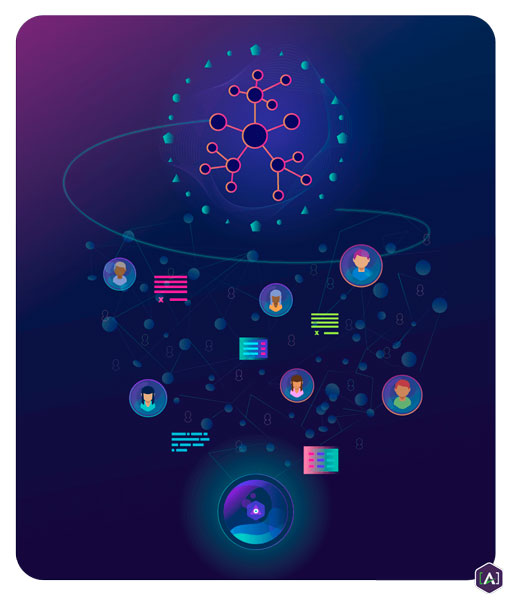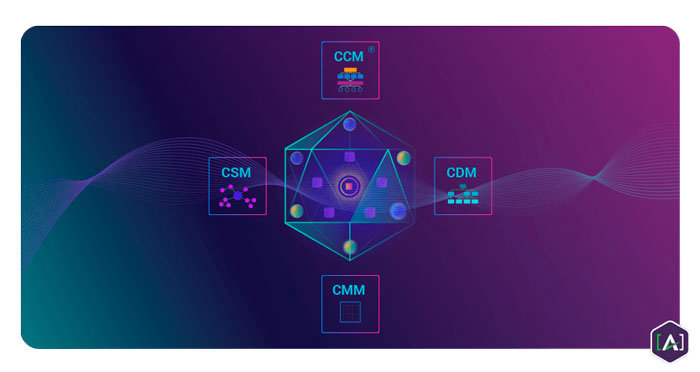To read the previous entry in this series from the [A] Semantics team for more context, click here.
The
CSM needs to be implemented in a content system in order to provide value to an organization. Implementing the CSM requires understanding how the CSM will fit into an organization’s general content architecture and selecting specific systems and platforms for that architecture.
Content Architecture

The CSM also helps document the relations between parts of a content architecture. For example the connections between the overarching strategy for an organization’s content, the content models like the
CCM and the CSM, and the operators who execute the organization’s strategy. The alignment involved is significant, and semantics makes aligned workflows and processes far more likely and therefore integrated success also more likely. Our interest here is specifically focused on noticing and consciously influencing how the CSM interacts with the enterprise content strategy and content architecture.
A central goal in incorporating semantics in a content architecture is to ensure that the semantics can be provided in a decoupled way to multiple systems across the content ecosystem. In the same way that many organizations decouple their authoring from their various systems of content management, so that the content is created on one platform but managed and formatted for delivery other ones, we want to do the same with semantics. We want content to be authored, annotated, managed, and delivered in systems that all reference the same semantics source.
The formal classification and interpretation of semantics is a dedicated function and needs a dedicated system that makes it possible to provide those semantics via API calls to other systems. Thus we empower the crucial role of a semantics platform that can enforce semantics across an organization’s entire content ecosystem.
System Selection
Implementing the content architecture requires selecting systems to realize it. In the case of the CSM, semantic systems will need to be selected that will act as the system of record for the organization’s
taxonomies,
ontologies, and
controlled vocabularies. Effectively employing a semantics system is crucial to leverage the many potential benefits of a CSM, such as:
- Content targeting and personalization
- Faceted, intelligent search experiences
- A rich corpus of content to aid chatbots and other conversational UIs
- Discovery of content assets for reuse and multipurpose value
- Reduce internal friction in creating consistent content across divisions
There is much to say on this topic. [A] has an article dedicated to understanding the semantic services vendor landscape. Those interested in more information are advised to consult this article, or reach out for details on an [A] workshop and support services to help with semantic platform requirements, selection, architecture, and integration planning.

A Protected, Chartered Function within a Content Services Organization
In order for a
Core Semantic Model to reach its full impact and maximum business value, it must be a living, breathing part of the organization, not a one-time artifact. No map remains valuable if it doesn’t change along with the landscape. Maps always change and semantics always changes. If protected and integrated, the CSM can continually provide value across systems and platforms, and across employees and customers over time.
Once the value of semantics is clear and a semantics program is underway, it’s time to operationalize the use of semantics as part of daily work. In order to nurture and grow the use of semantics and keep the Core Semantic Model relevant and functioning over time, the [A] recommends building a
Content Services Organization (CSO) that has a semantics function dedicated within it.
The
Content Services Organization has direct responsibility for developing and managing the models, processes, technologies, and roles that support content functions across a department or — better — a whole enterprise. The driving goal for the CSO is to support intelligent customer experiences by creating and facilitating content intelligence. It achieves this by incorporating
Content Strategy,
Content Engineering, and
Content Operations practices.
The CSO also oversees the
Content Orchestration Model (COM). This operating plan for content is used to align and help integrate all of the applications within the
Content Supply Chain. The semantics function supports and manages the semantics system of record for storing all of the semantic definitions contained within content systems throughout the Content Supply Chain. Using interconnected semantic references, content becomes more discoverable, personalized, fluid, automated, and is the foundation for Intelligent Customer Experiences.

[A] has recognized that content is a gestalt effect of many teams and functions working together. To rationalize it all, create team alignment and produce valuable results for Content Intelligence initiatives, [A] has built an integrated framework to unify content-related functions. To dive more into the operations side of content — download the Content Services Organization whitepaper here and learn more about the Content Services Organization and the
Content Orchestration Model.
Ongoing management and governance
After a Core Semantic Model is initially constructed, it will also need to be managed and governed. This requires developing teams and systems in charge of management and governance. These semantic operations teams will be tasked with several key tasks:
- Testing the performance of the CSM
- Ensuring that it abides by a widely adopted semantic standard like SKOS
- Updating it in light of any content-related changes within the organization
- Ensuring that the CSM is properly positioned in the organization’s content architecture to control the vocabulary and terminology of the organization’s content.
Management and governance teams will need to carefully pay attention to the following considerations:
- How well is the current CSM performing? The team must consider whether the CSM is missing any crucial semantic relationships or terms, or whether customers and agents understand terms in a different way from the modelers.
- How do content assets evolve? The team must be attentive to any changes in the CCM that affects the structure of the content assets. Changes in the CCM often require changes to the CSM.
- What new content assets are being created? When an organization adds new content assets, the CSM governance team (whether in a formal CSO or not) will need to determine how new content assets need to interact with an organization’s semantic map. This ensures new assets may be integrated to the whole of the enterprise knowledge ecosystem, and utilized to their fullest extent.
- What are new ways content is being used? If content assets are being used in a new way or have new dimensions, the semantic and structural models need to accommodate the changes. Whether it’s new output formats or methods, content targeting technology requiring additional tags, new SEO or structured data needs — really any new use of the content — the changes may require a modification to the CSM and CCM. Differences in how content assets are used can make a huge difference to the structure and semantic models supporting the management and interpretation of that piece of content.
- What new channels are being considered for content delivery? If new channels are developed for content delivery, then the modelers must ensure that content assets are effectively tagged and labeled to facilitate dynamic delivery to these new channels.

As we can see, semantics is an ongoing process because content itself is an ongoing process. Semantics must be maintained like maps must be maintained.
Contact Us for a Free Consultation.